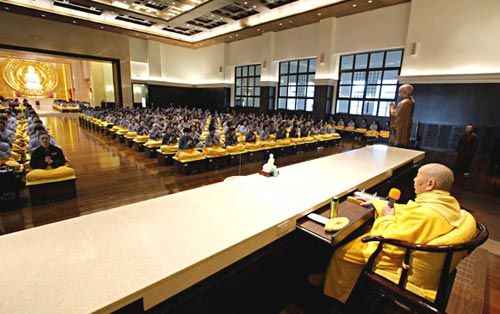 The Grand Master was a native of Yingshan, Sichuan province, China. In 1963, he was ordained as a novice under the Venerable Master Lingyuan, a Dharma heir of the Great Master Xuyun (Empty Cloud), at the Shi Fang Da Jue (Great Enlightenment) Chan Monastery in Keelung, Taiwan, and given the Dharma name Zhi’an Wei Chueh. Later on, he went on solitary practice in various monasteries, and also a hut on the secluded mountains of Wanli in northern Taiwan for more than a decade.
The Grand Master was a native of Yingshan, Sichuan province, China. In 1963, he was ordained as a novice under the Venerable Master Lingyuan, a Dharma heir of the Great Master Xuyun (Empty Cloud), at the Shi Fang Da Jue (Great Enlightenment) Chan Monastery in Keelung, Taiwan, and given the Dharma name Zhi’an Wei Chueh. Later on, he went on solitary practice in various monasteries, and also a hut on the secluded mountains of Wanli in northern Taiwan for more than a decade.
In 1987, urged by followers to share his Dharma teaching with more people, the Grand Master decided to build a monastery. Together with his disciples, he grubbed out weeds, cleared the ground, carried bricks, laid walls, until calluses grew on his palms and soles. Finally, Ling Quan Monastery was established at where his hut used to be. Soon after, he held his first “Chan-7” (a seven-day intensive Chinese Zen meditation retreat), which breathed new life into the hitherto declining Chan-7 practice in Chinese Buddhism. In 1991, for 49 days, the Grand Master conducted seven consecutive Chan-7, firmly reinvigorating the Chan tradition in Taiwan. Before long, Ling Quan could no longer accommodate the growing number of practitioners, so he started the plan to build a bigger monastery in Puli, Nantou in central Taiwan. After three years of planning and seven years of construction, Chung Tai Chan Monastery was finally inaugurated in 2001.
The Grand Master introduced many far-reaching programs to prepare the monastics to turn the Dharma Wheel. He initiated the “Three Links of Cultivation,” which integrates the disciplines of service, scripture studies, and meditation for a comprehensive spiritual practice, and applied this principle to promote sangha education, social education, and school education. From practicing in seclusion to turning the Dharma wheel, whether in action or in stillness, he had always diligently lived by the Buddhist teaching, leading his disciples to fulfill the bodhisattva way. Abiding by the motto “when at rest, rest all thoughts; when in action, perfect all actions,” the Grand Master set an exemplary model of Buddhist cultivation for all.
 While Chung Tai Chan Monastery was being constructed, the Grand Master concurrently founded the Chung Tai Buddhist Institute, as well as worked towards establishing 108 meditation centers in Taiwan and overseas. He also held large Dharma ceremonies, gave hundreds of rounds of Dharma lectures, conducted ten sessions of Chan-7 retreats annually, and transmitted the Three Refuges, the Five Precepts, the Eight Prohibitive and Fasting Precepts, and the Triple Platform Ordination and the Bodhisattva Precepts regularly. By his insightful teaching of the Dharma, meditation and precepts, the Grand Master transformed numerous lives with the purifying benefits of Buddhism.
While Chung Tai Chan Monastery was being constructed, the Grand Master concurrently founded the Chung Tai Buddhist Institute, as well as worked towards establishing 108 meditation centers in Taiwan and overseas. He also held large Dharma ceremonies, gave hundreds of rounds of Dharma lectures, conducted ten sessions of Chan-7 retreats annually, and transmitted the Three Refuges, the Five Precepts, the Eight Prohibitive and Fasting Precepts, and the Triple Platform Ordination and the Bodhisattva Precepts regularly. By his insightful teaching of the Dharma, meditation and precepts, the Grand Master transformed numerous lives with the purifying benefits of Buddhism.
For thirty years, he led his disciples to create the Chung Tai World, one step and one footprint at a time. With the Four Tenets of Chung Tai—to our elders be respectful, to our juniors be kind, with all humanity be harmonious, in all endeavors be true—he set down the guiding principles for practicing Buddhism and upholding sangha integrity. Through connecting Buddhism with academia, education, art, science and daily living, he brought the Dharma to a broad spectrum of people, kindling the light inherent in everyone’s original nature.
He also actively advocated Buddhist and cultural exchange across the strait, promoting mutual prosperity on both sides and peace of the world. Moreover, based on the education of enlightenment in Buddhism, he founded Pu Tai elementary, junior high and senior high schools, setting up a model for a well-rounded education system. To give testimony to the history of Buddhist development, and to preserve traditional Chinese culture, he dedicated himself to the establishment of the Chung Tai World Museum, opening a platform for spreading the Dharma through the transforming power of art.
On April 8, 2016, the Grand Master completed his lifelong journey of bodhisattva work; surrounded by his monastic disciples, he passed on peacefully at the age of 90. More than 30,000 disciples lined up to bid final farewell to our beloved teacher on the day of his cremation.
Outwardly manifest as an ordained monk,
Inwardly accord with the supreme Buddha seal;
Unwaveringly practice the bodhisattva way,
Guiding all sentient beings to enlightenment.
These are not only the Grand Master’s aspirations for his monastic disciples, but also a portrait of his own life.
From his legacy—Chung Tai—Chan spreads far and wide, taking root wherever it lands. In order to honor the Grand Master for his spiritual guidance, members of Chung Tai will uphold the founder’s vision to bring purity and inner peace to all walks of life with Buddhism, thus completing the bodhisattva path of benefitting the self by benefitting others.
